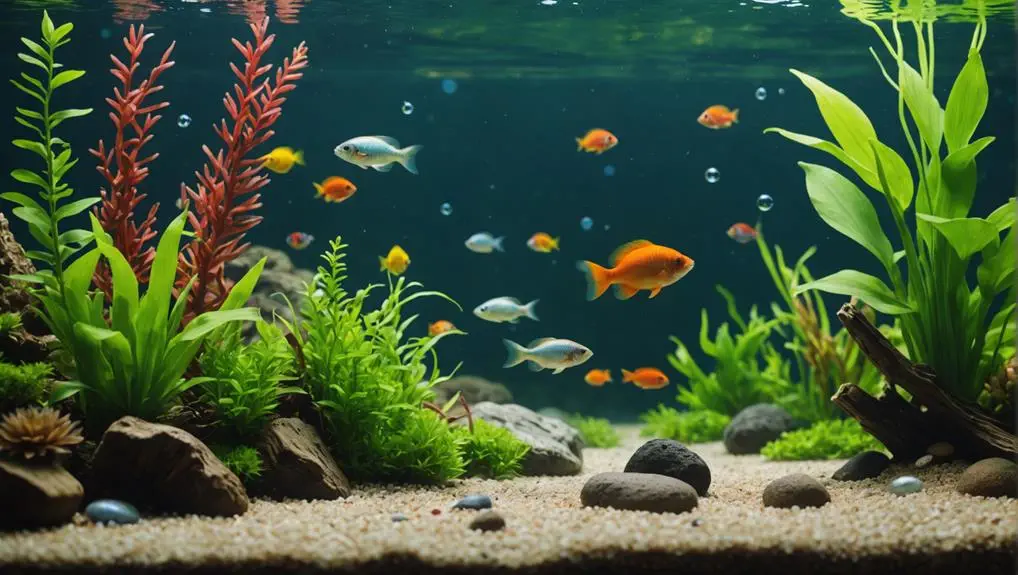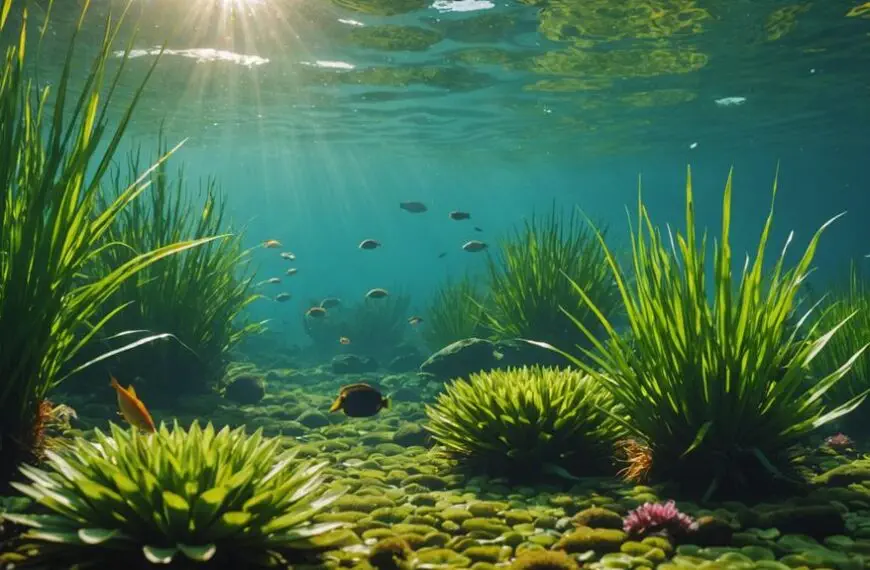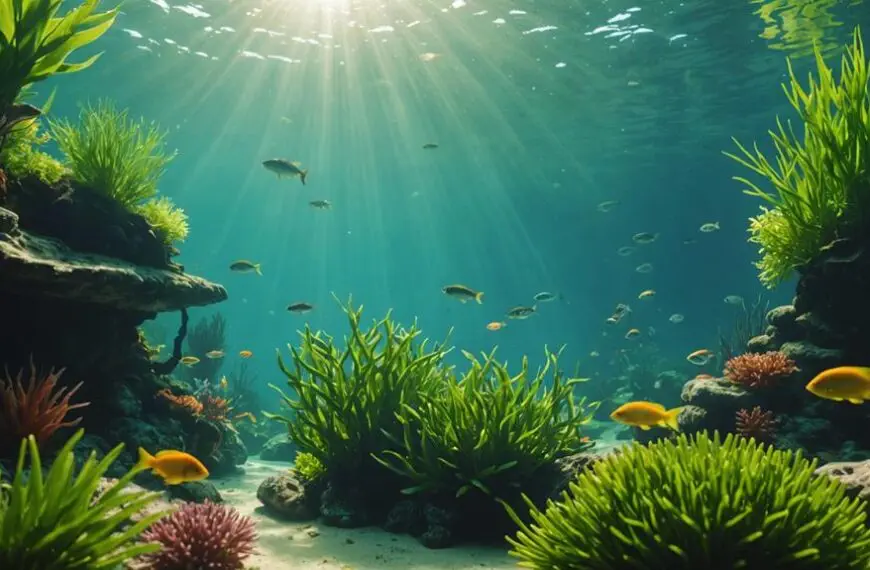Natural filtration methods for fish tanks use natural elements like live rock, deep sand beds, and macroalgae to keep your aquatic pals happy and healthy. The live rock offers a cozy home for beneficial bacteria that break down waste, while the sand beds help reduce harmful nitrates through denitrification. Macroalgae love soaking up excess nutrients, making them great for keeping water clean. A little routine maintenance, like regular water changes and monitoring parameters, goes a long way. Trust me, your fish will thank you! Curious about how to set this up for your tank? There's even more to discover!
Contents
Understanding Natural Filtration
Understanding natural filtration can transform your fish tank into a thriving ecosystem. You might feel like a fish whisperer as you create a home that mimics nature!
This method relies on live rock and deep sand beds, which provide a cozy habitat for beneficial bacteria. These little helpers break down waste and organic matter, keeping your tank clean and your fish happy. Additionally, incorporating beneficial bacteria can help compete with algae for nutrients, further enhancing the water quality.
To maintain good water quality, regular water changes are crucial. Aim for about 10% to 20% weekly to prevent nutrient spikes—nobody wants a tank party gone wrong!
Deep sand beds are fantastic too; they allow anaerobic bacteria to flourish, making filtration a breeze.
Don't forget about macroalgae! These green wonders not only look great but also offer grazing opportunities for your fish while capturing excess nutrients.
You're not just creating a pretty tank; you're cultivating an ecosystem that works together harmoniously.
With the right balance of natural filtration, you'll see your fish thriving, and you'll feel a sense of pride knowing you're serving both your aquatic friends and the environment.
Dive in, and let your fish tank flourish with life!
Benefits of Live Rock and Sand
Live rock and sand are the backbone of a healthy aquarium ecosystem, offering numerous benefits that enhance filtration and overall tank stability.
When you add live rock, you're not just decorating your tank; you're creating a surface for beneficial bacteria to thrive. These tiny helpers significantly boost biological filtration, keeping your nitrogen cycle in check and promoting stable ecosystems that reduce stress and illness in aquatic populations.
A sand bed, ideally between 1/4" and 4" deep, plays a crucial role too. It supports anaerobic bacteria that work hard to reduce harmful nitrate levels through denitrification. This process is essential for keeping your fish happy and healthy.
Plus, using live sand, whether fresh or from an established tank, helps with nutrient cycling and provides a cozy habitat for microscopic organisms that are vital for maintaining tank health.
Don't forget—you can enhance your aquarium's natural filtration by monitoring key water quality parameters. Keeping a small amount of high-quality live rock can simplify your maintenance routine. It reduces the chances of system crashes that often happen when you rely too much on mechanical filtration.
Role of Macroalgae
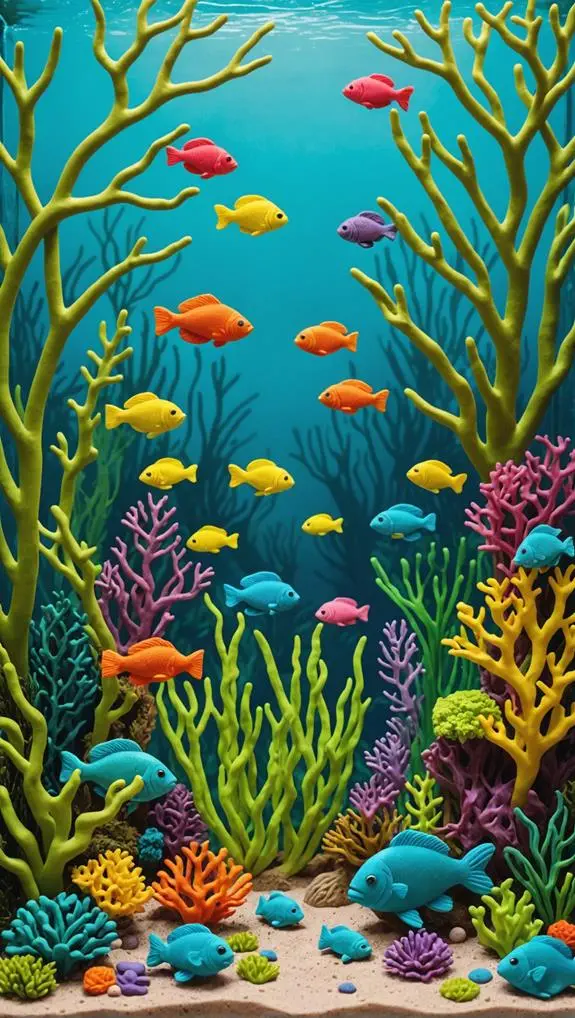
Macroalgae, including varieties like Red Grapes and Dragons Breath, are essential for maintaining a balanced aquarium ecosystem. They help with nutrient management by absorbing excess nitrates and phosphates, which keeps your water quality in check.
Plus, these colorful plants offer grazing opportunities for your herbivorous fish, ensuring their dietary needs are met and contributing to the overall health of your aquatic community.
When you set up a refugium, using macroalgae can enhance natural filtration processes and promote biodiversity in your tank. You'll love how they thrive in various lighting conditions, making them adaptable to any environment.
And let's not forget the aesthetic enhancements! With their vibrant colors and diverse textures, they can turn your aquarium into a living artwork.
However, it's crucial to keep an eye on them. Regular pruning is necessary to prevent overgrowth; after all, you want them to be effective without throwing your tank off balance.
Managing Nutrient Levels
Keeping your fish tank's nutrient levels in check is crucial for a happy and healthy underwater world.
You can achieve this through regular water changes, ensuring trace elements are balanced, and using macroalgae to soak up those pesky excess nutrients.
Trust me, a little effort here means a lot less stress for your fish—and hey, who doesn't want to make their aquatic buddies happy?
Regular Water Changes
Maintaining optimal nutrient levels in your fish tank hinges on the practice of regular water changes. Think of it as giving your aquarium a refreshing drink. By replacing 10-15% of the water weekly, you're not only keeping those essential nutrients flowing but also preventing the buildup of pesky nitrates. Nobody wants a fishy spa day gone wrong, right?
Regular water changes help create a healthy environment for your fish and corals. As organic decay happens, nutrients can get depleted, but don't worry! Your maintenance regime can easily replenish what's lost.
Plus, establishing a routine boosts system stability, reducing the chance of sudden spikes in harmful substances.
Make sure you're monitoring water parameters before and after each change. This way, you can confirm your efforts are paying off and adjust nutrient levels if needed. By staying on top of this, you create a thriving aquarium ecosystem where everyone—fish, plants, and even you—can flourish.
Trace Element Balance
Achieving a balanced trace element level in your fish tank is crucial for the health of your aquatic life. You want to create a thriving environment for your fish, and that means managing nutrients wisely. Regular water changes of 10-20% each week help keep toxic ammonia at bay while preventing harmful nitrates from building up.
Using live rock and live sand is another fantastic way to naturally replenish those important trace elements. As organic compounds break down, they release essential nutrients that support a healthy ecosystem.
Plus, you'll find that nitrifying bacteria flourish in this environment, keeping everything in check.
While it's tempting to add a splash of trace elements, be careful! Overdosing can happen without regular testing. Instead, consider adding macroalgae like Red Grapes or Dragon's Breath. They not only help with nutrient management by gobbling up excess nitrates but also contribute trace elements essential for your tank's inhabitants.
And hey, skipping things like protein skimming can actually help retain those beneficial elements your corals crave.
With a little attention and care, you can create a balanced, vibrant underwater world for your fish to thrive!
Macroalgae Utilization
Utilizing macroalgae like Red Grapes and Dragon's Breath can significantly enhance your fish tank's nutrient management. These vibrant plants are fantastic at absorbing excess nutrients such as nitrates and phosphates, which helps keep those pesky algae blooms at bay.
By placing them in refugiums or well-lit areas, you'll promote their growth and boost nutrient uptake, making your tank a healthier home for your aquatic friends.
Not only do macroalgae improve water quality, but they also serve as a natural snack for herbivorous fish and invertebrates. This adds to the overall biodiversity of your aquarium, making it a lively ecosystem.
Plus, when you maintain nutrient levels close to zero with macroalgae, you reduce the need for chemical filtration methods. This creates a more stable environment, especially for delicate species that need a little extra TLC.
Don't forget to practice regular harvesting! This keeps your macroalgae from overaccumulating while supporting new growth.
Maintenance Practices for Natural Systems
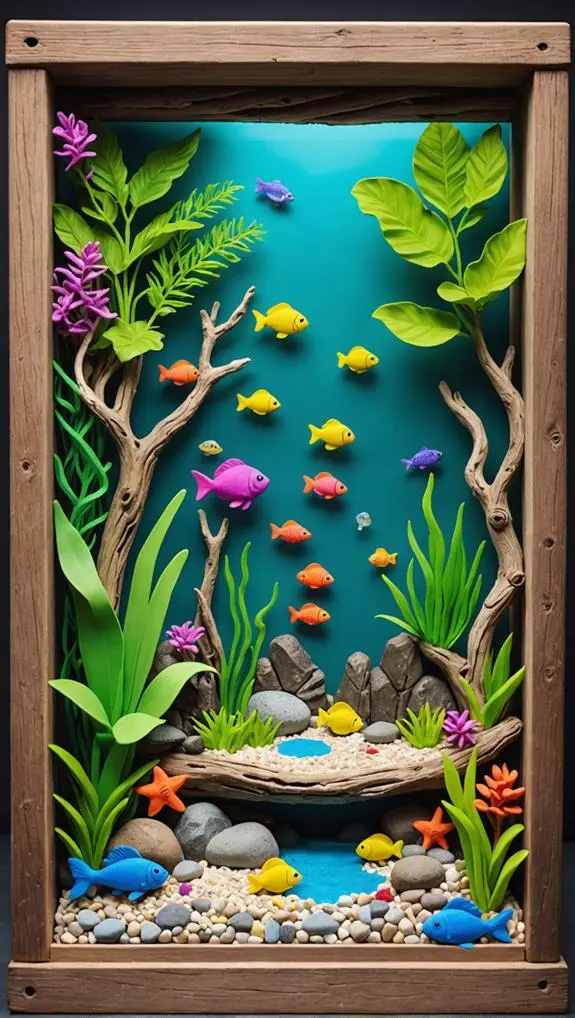
A well-maintained natural filtration system is crucial for the health of your fish tank. By sticking to a few key maintenance practices, you can ensure your aquatic friends thrive in a balanced environment.
Here's what you need to focus on:
- Schedule weekly water changes of 10% to 20%, as this improves water quality by reducing harmful nitrates and replenishing essential minerals.
- Manually clean your sandbed to remove detritus.
- Use filter socks monthly for better water clarity.
- Monitor nitrate levels to prevent algae blooms.
Regular water changes help maintain nutrient levels and overall system health.
Cleaning the sandbed is essential for optimal bio filtration, especially in low bioload setups. Plus, those filter socks can capture excess detritus that might otherwise cloud your tank.
Relying on live rock in your sump provides biological filtration, making your tank more stable and minimizing mechanical maintenance.
But don't forget to keep an eye on those nitrate levels!
Addressing high levels and algae blooms through careful monitoring can save you from a tank disaster.
Your fish will thank you for it, and you'll enjoy crystal-clear water, making your underwater world a joy for everyone!
Community Experiences and Insights
Many aquarists find that sharing their experiences with natural filtration methods creates a wealth of knowledge within the community.
You'll discover that using live rock and sand beds can help you establish a self-sustaining ecosystem. This not only simplifies nutrient management but also cuts down on your maintenance efforts. Many hobbyists report that they achieve long-term tank stability this way, often keeping hardy coral species without relying on mechanical aids.
Regular discussions in forums emphasize the importance of weekly 10-20% water changes and the use of filter socks to maintain water quality. Community members often highlight how relying heavily on live rock for biological processing reduces the need for mechanical cleaning. This fosters a balanced natural environment, making your aquarium hobby more enjoyable.
The best part? Sharing your journey with others can enhance collective knowledge.
When you engage with established hobbyists, you'll learn effective strategies to tackle challenges in natural filtration. So, dive in, share your insights, and soak up the wisdom from fellow aquarists. Together, you can create thriving, beautiful tanks that bring joy to everyone involved!
Frequently Asked Questions
What Is the Best Filtration Method for Aquariums?
The best filtration method combines mechanical, biological, and chemical filtration. You'll enhance tank water clarity, support fish health, control algae growth, and explore eco-friendly alternatives while ensuring effective filtration system maintenance and diverse filtration media options.
What Are the Three Types of Filtration for Fish Tanks?
You've got three main filtration types for your tank: mechanical filtration for solid waste, biological filtration for ammonia conversion, and chemical filtration for improving water clarity. Each enhances aquarium health through proper filter placement and effective filtration systems.
What Can I Use as a Filter for My Fish Tank?
When you're considering a gentle approach for your fish tank, think of sponge filters, aquatic plants, or gravel beds. Coconut shells, sand filters, and bio balls can also enhance your aquatic sanctuary beautifully.
What Are Forms of Natural Filtration?
You'll find forms of natural filtration include biological, chemical, and substrate filtration. Incorporating plant and sponge filtration enhances surface area, promotes microbial reduction, and offers eco-friendly options, while algae benefits your tank's overall health.
Final Thoughts
Incorporating natural filtration methods in your fish tank can be a game-changer. Did you know that aquarists often find their tanks are up to 50% healthier with live rock and macroalgae? By embracing these natural systems, you're not just creating a beautiful underwater world; you're also promoting a thriving ecosystem. So, keep those nutrient levels in check and enjoy the vibrant community of fish and plants. Happy fishkeeping, and remember, your aquatic pals appreciate your efforts!

